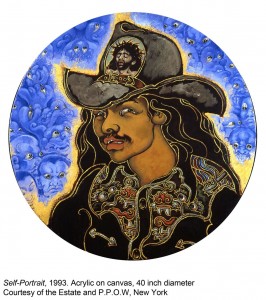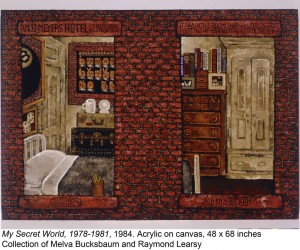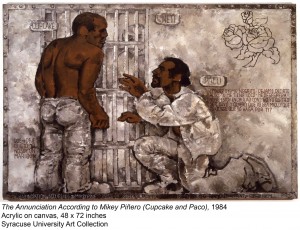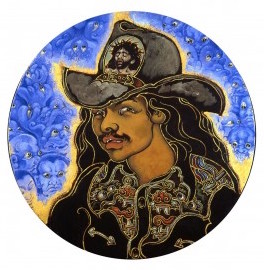WHEN, IN AN INTERVIEW, curator and art chronicler Yasmin Ramirez asked American painter Martin Wong why he left his native San Francisco in 1978 and moved to New York, Wong said he went there “just to visit and then I ended up almost immediately living there.” Aligning himself with black and Latino graffiti artists and poets on the Lower East Side, including the legendary Puerto Rican writer and ex-con Miguel Piñero, his friend and sometime lover, Wong nevertheless described himself as a “tourist” there. If indeed he felt like an outsider—and Wong, Asian and gay, could certainly look like one, flamboyantly dressed, as he often was, from head to toe, like an urban cowboy—as an artist he penetrated deeply into the social terrain that he was observing.
 It was in New York—city of darkness in contrast to San Francisco, city of the golden sun and the azure sky—that Wong found himself in the late 1970s, and it is where he created his most important works. It was as if New York’s underside seemed more real to Wong than the phantasmagoric, hallucinatory world of San Francisco in the Counterculture years, even though that city had emerged as the epicenter of (largely white) gay cultural life.
It was in New York—city of darkness in contrast to San Francisco, city of the golden sun and the azure sky—that Wong found himself in the late 1970s, and it is where he created his most important works. It was as if New York’s underside seemed more real to Wong than the phantasmagoric, hallucinatory world of San Francisco in the Counterculture years, even though that city had emerged as the epicenter of (largely white) gay cultural life.
Wong died of AIDS-related causes in 1999, and the memory of his extraordinary output over a short span of about two decades in the ’80s and ’90s has begun to fade in recent years. This situation has been partly corrected by the comprehensive show mounted this past winter, Martin Wong: Human Instamatic, jointly organized by Ramirez and curator–poetry scholar Sergio Bessa (he also edited the superb catalog), at the Bronx Museum of the Arts. (The exhibit continues at the Wexner Center for the Arts in Columbus, Ohio, from May 14 through August 7, 2016; and moves to the U.C.-Berkeley Art Museum September 12 through December 10, 2017.)
Much of Wong’s most noteworthy art addresses, with anthropological acumen and a vivid fantasism, Latino and black life in the 1980s on the decaying Lower East Side—“the Loisaida”—as well as life behind bars, the inevitable adjunct for many of the people who lived there. Wong depicts the bleakness of pre-gentrified Loisaida, but he also locates aspects of its vibrancy and beauty, whether it’s a couple holding one another in the rubble of a vacant lot (Sharp & Dottie, 1984) or two firemen kissing in front of what looks like a deserted brick building in 1988’s Big Heat. (As a boy in San Francisco’s Chinatown, Wong was never as happy as when standing on a fire truck. Firemen appear often in his work, such as in his 1988 text painting, I Really Like the Way Firemen Smell, and My Fire Guy, also 1988, which shows a fully uniformed fireman in bed tenderly cradling a puppy.)
Wong’s life can be conveniently divided into two parts, his early life on the West Coast and his life in the East. He came from a middle-class Chinese-American family, a doted-upon only child growing up in relative comfort in the 1950s and ’60s. He enjoyed collecting, along with his mother, artsy tchotchkes and Asian artifacts, showed a talent for drawing the human figure (his early self-portraits in this exhibit demonstrate a stunning ability), and studied ceramics at Humboldt State University in Eureka. He returned to San Francisco from Eureka for a period in the early 70s and became an artist activist, providing materials for the gender-bending, communal-oriented Angels of Light, an offshoot of the Cockettes.
 With his move to the East, an altogether new life began. Wong was in his early thirties when he traveled to New York, where he stumbled upon the run-down Meyer’s Hotel at South Street Seaport, which is where he would live and paint for three years, refining his representational painting techniques, largely unknown to the outside world. It is there that he painted My Secret World (1978-81, 1984), a work that would prove seminal to his vast output in the 1980s, illustrating as it does many of his artistic concerns. When Ramirez asked him in that same interview in 1996—the transcript of which is included in the catalogue—what would characterize “classic Martin Wong themes,” the artist answered: “Bricks and jails.”
With his move to the East, an altogether new life began. Wong was in his early thirties when he traveled to New York, where he stumbled upon the run-down Meyer’s Hotel at South Street Seaport, which is where he would live and paint for three years, refining his representational painting techniques, largely unknown to the outside world. It is there that he painted My Secret World (1978-81, 1984), a work that would prove seminal to his vast output in the 1980s, illustrating as it does many of his artistic concerns. When Ramirez asked him in that same interview in 1996—the transcript of which is included in the catalogue—what would characterize “classic Martin Wong themes,” the artist answered: “Bricks and jails.”
With its pollution-dimmed brick façades and chiseled inscriptions, My Secret World offers a sort of voyeuristic view, through two large openings that aren’t quite windows, into the artist’s room at the Meyer’s Hotel. It is a small room with a tidily made bed and a simple dresser. Parts of several of the artist’s earlier paintings can be seen on the wall: one shows a large eight-ball, another a pair of dice. A third painting, from 1980, titled Psychiatrists Testify: Demon Dogs Drive Man to Murder (the last two words aren’t visible), refers to the New York serial killer Son of Sam. It consists of American Sign Language hand gestures that spell out the title. Books atop the dresser include Picturebook of Freaks, Famous Disasters, How to Make Money, Magic, Flying Saucers, Pirate Stories, and Unbeatable Bruce Lee.
 In his catalog essay, poet and critic John Yau points out that “Wong’s images of bad luck and good luck are part of his worldview, along with his interest in different kinds of language, from the aural hallucinations of the insane to the hand signals of ASL.” The books that he puts on display attest to his male hero worship and interest in male adventure, a desire to make both art and money (a common conflict for many artists), his Asian identity, and his inward sense of alienation.
In his catalog essay, poet and critic John Yau points out that “Wong’s images of bad luck and good luck are part of his worldview, along with his interest in different kinds of language, from the aural hallucinations of the insane to the hand signals of ASL.” The books that he puts on display attest to his male hero worship and interest in male adventure, a desire to make both art and money (a common conflict for many artists), his Asian identity, and his inward sense of alienation.
Wong’s aim as a painter was far more than just to act as a documentarian; otherwise, photography would have suited his purposes. His use of paint, particularly in his ubiquitous portrayal of brick walls and buildings—layering up earthy browns, burnt sienna, and ochers in a richly textured, sensuous way—is an æsthetic nod not only to his own experience making art from clay but also to the history of modernism, with its emphasis on paint as a tactile medium, the importance of color dynamics on the surface of the canvas, and the many uses of abstraction. Beyond that, one can see influences as disparate as R. Crumb, the countercultural cartoonist of “Mr. Natural” fame in the ’60s; Fernando Botero, the great Colombian painter of bulbous human figures; and Mondrian, with his commitment to geometric shape and balance (Wong owned a Mondrian drawing).
One recurrent element in numerous Wong paintings, the spelling out of titles through American Sign Language—which he began doing in 1980 with Psychiatrists Testify—can come off as slightly gimmicky, especially in paintings in which the ASL gestures are dominant. Fisted hands that resemble gnomic people, they can be a distraction, introducing the framework of a visual language that feels out of place. It’s as though Wong were trying too hard to be cryptic; or that somehow his realism isn’t enough in an art world that demands irony, sophistication, and double meanings. On the other hand, signs and symbols often do work for Wong, as in Tell My Troubles to the Eight Ball, that symbol of random answers, and in the exquisite Chinese Altar Screen, with its echoes of Duchamp, Rauschenberg, and Magritte.
A pivotal event in Wong’s life was meeting Piñero in 1981, at ABC No Rio, the alternative arts center on the Lower East Side, where Wong was exhibiting his work. In and out of prison for theft and drug possession, Piñero, who co-founded Nuyorican Poets Café, is best known for his play-turned-film Short Eyes, which describes the intricate power relationships and rituals of degradation in prison society. Piñero told Wong prison stories and revealed a world unknown to the artist. Wong tells Ramirez that “when Piñero was here I would just meet all of these beautiful gangsters. Yeah for awhile I lived with Piñero, and for awhile I lived with [graffiti artist]Lee Quinones and both times I guess it was like living with a Puerto Rican movie star or an ex-movie star.”
It is evident throughout his body of work that Wong was a painter with a keen understanding of art history, not just in the 20th century, but going back to the Renaissance and earlier. It’s interesting that Wong made his first sale of a major work in 1984 to that great temple of art antiquities, the Metropolitan Museum of Art. The painting was titled Attorney Street (Handball Court with Autobiographical Poem by Miguel Piñero). Wong also worked at the Met’s bookstore for a time in the late 1980s.
An icon of the Western canon, the Annunciation has been painted by El Greco, Caravaggio, Fra Angelico, and countless other artists. In Wong’s version, 1984’s The Annunciation According to Mikey Piñero (Cupcake and Paco), a man dressed in a white prison uniform kneels before a shirtless and muscular inmate. The painting has overtones of an attempted seduction, without any sense of coercion. Looking at the painting, one can imagine that the man who’s kneeling is trying to convince the other man, who seems ambivalent, to give it a try. One could imagine him saying something like, “I know you’re straight, but we’re in this place and somehow we have to survive.” The title’s reference to the Annunciation could be interpreted as purely ironic, but that would be too reductive. In a prison world where one may not always get to choose one’s sexual partner, same-sex love represents a more humane possibility, rare as it may be, to create a genuine human bond.
After he was diagnosed with AIDS, Wong left New York and returned to San Francisco to spend his last few years living with his parents. Growing in his mother’s small back yard, amid a handful of his early ceramic pieces, were succulents and cacti, exotic plants with origins in another part of the world that could nonetheless thrive in this alien coastal climate. Painted in stark black and white in 1997-98, Euphorbia Obesa and Mammillaria Wildii Crest, for example, contain orb-like forms, striated and furrowed, that call to mind close-ups of the brain. Considering the artist’s courage and brilliance, and the disease that was slowly killing him, it seems fitting that they are among Wong’s final paintings.
James Cassell, an artist and writer, lives in Silver Spring, MD. His last show was in 2014 at Studio 21 Gallery in Washington, DC.







Discussion1 Comment
Pingback: Gay Painters: Most Have Never Heard of These 15 Amazing Artists